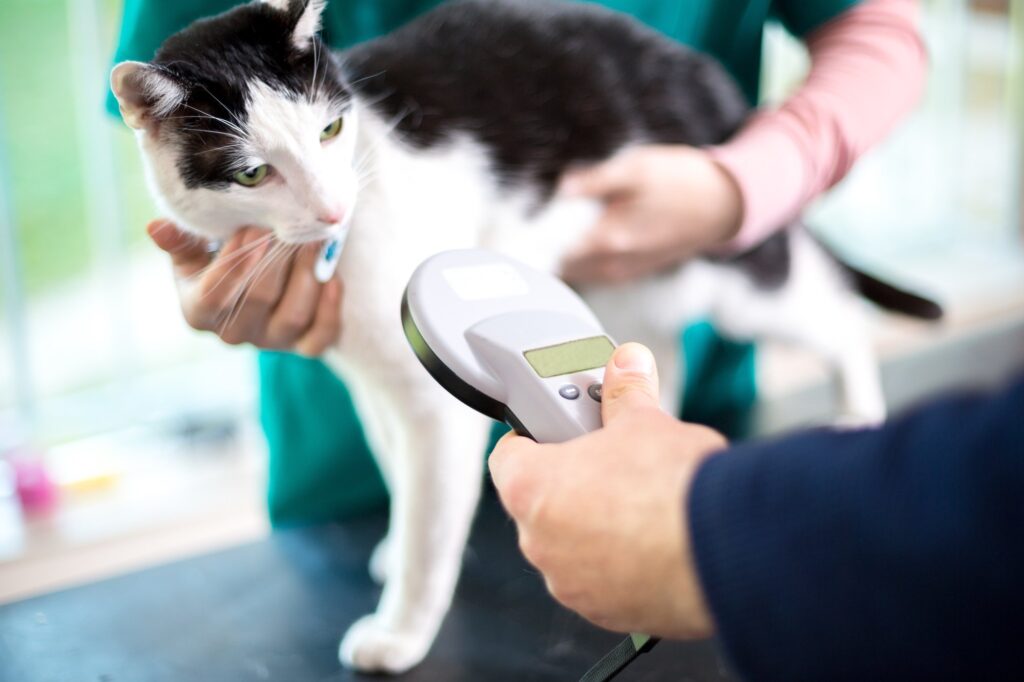
Does your pet have a tendency to get loose and go missing? If you want to optimize the chances of reuniting with your furry friend, it may be time to talk to your vet about microchipping.
Before you do, read this guide to pet microchips, where we answer some of the web’s most commonly asked questions about this convenient service.
What Is a Pet Microchip?
A pet microchip is a tiny electronic transponder that acts as a permanent means of identification. A veterinarian will insert the chip beneath the skin between your pet’s shoulders and activate it using a radiofrequency scanner.
If your pet goes missing and winds up at a shelter, the shelter can scan for a microchip. Their scanner will display an identification number, which they can then use to find your phone number or address.
Pet identification tags also serve a similar purpose. The difference is that these tags can be removed, broken, or otherwise compromised. Microchips, on the other hand, are permanent and completely tamper-proof.
What Information Is on a Pet Microchip?
A pet microchip contains information about the pet and its owner’s identity. Specifically, the scanner will bring up the identification number of the chip, which shelters can then use to call the manufacturer.
Pet microchip manufacturers keep registries of information about their clients. They can help the shelter track down your number, address, or other contact information you submit to the manufacturer’s registry.
Can You Track Your Own Pet With a Microchip?
No, you can’t track your pet with a microchip. It does not work like a GPS system. You, a vet, or a shelter can only access the information on a chip by scanning it with a radiofrequency scanner.
If you are interested in tracking your pet’s location, other products are available on the market. For example, Tractive is a GPS tracker pet parents can use to ensure they always know their furry friend’s exact location.
Is There a Downside to Pet Microchipping?
Yes, there are some downsides to microchipping, including that these products do not replace the need for pet identification and rabies tags. Microchips are also not foolproof, making it possible for your pet’s chip to go undetected.
Other potential complications of pet microchips include site reactions (more on these later). There is a small risk of tumor formation and cancer from microchips, but it is very low.
To avoid these downsides, only get your pet microchipped by a professional. Also, consider getting an ISO Standard microchip (more on this later) to ensure it is recognizable by all types of scanners.
How Much Does a Pet Microchip Cost?
A pet microchip costs $25 to $60 on average, meaning some will cost more and others less. This average accounts for the chip itself, the procedure needed to place it, and, sometimes, the registration fee.
If you are worried about the cost of microchipping your pet, ask your vet about lower-cost options. Some shelters and non-profit organizations offer low or no-cost microchipping services.
How Long Does a Pet Microchip Last?
A pet microchip will last for at least 25 years once it is implanted. Most household pets live for 25 years or less, meaning the microchip will last the entirety of your pet’s life.
Animals with longer life spans may require a second microchip after 25 years. For example, some horses can live for longer than 30 years. Ask your vet about the brands with the longest lifespans if you need to microchip your horse.
Types of Pet Microchips
There are dozens of types of pet microchips out there. Later, we will discuss how to choose the right manufacturer. But first, let’s discuss the various types of pet microchips available.
Pet Microchips by Frequency
Pet microchips come in three different frequencies. Each frequency requires a unique type of scanner to activate the chip after it is placed and scan it after someone has found your lost pet. The most common microchip frequencies are:
- 125 kHz
- 128 kHz
- 134.2 kHz
Universal scanners can detect all three frequencies. Another type of scanner-forward-reading scanners-will only detect 134.2 kHz chips but not 125 or 128 kHz microchips.
Pet Microchips by ISO Standard
The International Standards Organization (ISO) sets global benchmarks for safe, reliable, and high-quality products, including pet microchips. The ISO only approves chips with a frequency of 134.2 kHz.
You may not think the ISO standard frequency is a big deal. But consider this: the standard frequency is the only frequency used universally throughout North America, Europe, and other participating regions.
Additionally, all types of microchip scanners available today can read 134.2 kHz frequencies. So, ISO standard microchips give you the best chances of recovering your pet if he or she goes missing.
Do All Pets Need Microchips?
No, not all pets need microchips. Dog microchipping is mandatory by law in many states, but some do not have the same requirements for other types of animals.
In California, microchipping dogs and cats is a legal requirement. Owners of these animals must have pets over the age of four months microchipped unless the pet qualifies for an exemption.
Many pet parents choose to have other animals microchipped anyway. It is most common to microchip pets at risk of going missing, such as rabbits, snakes, hamsters, and other small critters.
But it is not unknown for large animals that are not at risk of running away to get microchipped. For example, some owners microchip horses to protect their investments.
Benefits of Microchipping Dogs and Other Pets
There are countless benefits to microchipping your pets. Below, we’ve rounded up three of the most important ones. Keep reading to learn more about why you should consider microchipping your dog, cat, or small pet.
Get Extra Protection
Dog tags, tattoos, and other physical means of identification are all well and good. But if your pet gets lost, these items are easy to damage and prone to intentional tampering. Microchips are different.
A study of nearly 8,000 animals picked up by shelters found that microchips significantly increase the chances of a stray being returned to their owner.
Streamline International Travel
Do you plan to take your pet with you wherever life takes you? If so, a pet microchip is essential. Many countries require pets to have a microchip before you can bring them with you during your travels or if you are relocating.
The following popular destinations require you to have your pet microchipped before entering the country:
- Australia
- The Bahamas
- China
- England
- Fiji
- France
- Germany
- India
- Ireland
- Israel
- South Korea
- New Zealand
- Nigeria
- The Philippines
- Puerto Rico
- Scotland
- Singapore
- South Africa
- Spain
- Sweden
- Turkey
- Wales
You can find a full list of the countries requiring pet microchipping at this link.
Enable Pet Tech
Many convenient pet tech products work in tandem with microchips. For example, there are electronic pet doors that open when they come in contact with your pet’s chip ID.
These products allow pets to relieve themselves on their own. But without a microchip, pet parents can’t take advantage of this convenient technology.
The Microchipping Procedure
If you adopt your pet from a shelter, microchipping services will be available before you bring your new furry friend home. Veterinarians also keep microchips on hand for interested clients.
Wondering what to expect from the microchipping procedure? Read on to learn the most important facts.
Inserting the Microchip
The microchipping procedure is minimally invasive and does not require surgery or anesthesia. Instead, the microchip is loaded into a syringe and injected into your pet, similar to how they receive their regular shots.
If you are concerned about your pet’s comfort, consider having them microchipped during a regular dog or cat surgery. For example, you could have your pup microchipped while receiving a dog surgery like spaying or neutering.
Monitoring and Aftercare
Your Westlake vet will give you instructions regarding caring for your pet after having a microchip placed. These instructions will include abnormalities to look out for at the injection site.
Potential complications include oozing, swelling, redness, or hair loss around the injection site. These symptoms could indicate a reaction or injection. Contact your vet or schedule an appointment if you notice these abnormalities.
Registering the Microchip
The only other task you must complete after the procedure is to register the microchip. Registration is free and only requires the microchip number and phone number for the manufacturer’s customer service portal.
Keep your pet’s registration updated, especially if you move or your phone number changes. Also, ask a vet near me to scan the chip a few times per year to ensure it continues to function properly.
How to Choose the Right Pet Microchip Brand
Finding the right pet microchip brand can be as simple as asking a trusted vet or inquiring at a local shelter. You can also purchase microchips yourself. Here are some qualities to look for should you choose to go that route.
ISO Standard
There is no requirement to get an ISO standard microchip unless you are traveling to certain countries. However, the ISO standard offers added benefits that non-ISO standard chips do not.
For one, ISO standard microchips are readable by all types of scanners, both in the US and abroad. Non-ISO standard chips can only be read by universal scanners. Forward-reading scanners cannot detect them.
ISO standard chips come in handy if your dog is picked up by a shelter with only forward-reading scanners. Without an ISO standard chip, you may not be reunited with your pet after he or she goes missing.
Warranty
Always go with a chip manufacturer offering warranties on their products. Many brands offer up to three-year warranties on their products, while others provide 12-month or even lifetime warranties.
A microchip warranty will protect your purchase in case the chip is defective. For example, say your vet finds that a newly implanted chip is non-functional during a routine check-up.
In that case, the manufacturer will send you a new chip at no extra cost. The only exception is if the chip was damaged in an accident, intentionally, or because of product misuse.
Added Features
Many brands offer ISO standard chips with built-in warranties. What truly distinguishes brands from each other is the added features offered, such as:
- Personal online account access
- Personal information security and privacy
- Free account updates
- Backup contact fields
- Vet integration
Some brands also offer convenient automated lost pet alerts. You can push a notification to vets and shelters in your area if your pet is lost, further improving the chances of being reunited with your furry friend.
How to Choose the Right Pet Microchip Registry
After choosing your brand of microchip, you must then decide where you want to register it. Some manufacturers require you to work with certain chip registry sites, while others leave the choice up to pet owners.
Free Registries
Are you looking for the most affordable option? Consider the following registries, which offer free basic registration:
- 24 Pet Watch
- Fi
- Find Pet
- Free Pet Chip Registry
- Furreka
You can also register your chips free with Save This Life. However, this offer is only available to pet owners with Save This Life branded chips.
Registries With Apps
Do you want to receive push notifications every time your pet’s chip is scanned? There’s an app for that with the following registries:
- Find Pet
- Global Pet Security
- Pet Key
Only Find Pet offers their registry app at no cost. Global Pet Security and Pet Key charge $125 and $45 (lifetime), respectively.
Premium Registries
Do you want the option to upgrade to premium features? If so, the following services are best for you:
- 24 Pet Watch
- Home Again
- Pet Key
24 Pet Watch and Home Again require an annual subscription fee. Pet Key allows for a one-time, lifetime payment of $60 to $119 to access the full suite of premium features.
Get Your Pet Microchipped at a Thousand Oaks Vet Clinic
If your pet is not microchipped yet, it is time to talk to a vet about the benefits of this life-saving service. Pet microchips allow vets and shelters to access your information should your pet go lost.
Are you searching for a ‘veterinary near me’ offering microchipping services? Slaton Veterinary Hospital in Westlake Village, CA offers all the pet care services needed to keep your furry friend safe and healthy.
Schedule an appointment with us to learn more about microchipping your pet. We also accept walk-in appointments!








